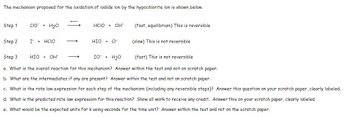
Chemistry
10th Edition
ISBN: 9781305957404
Author: Steven S. Zumdahl, Susan A. Zumdahl, Donald J. DeCoste
Publisher: Cengage Learning
expand_more
expand_more
format_list_bulleted
Question

Transcribed Image Text:The mechanism proposed for the oxidation of iodide ion by the hypochlorite ion is shown below.
Step 1
Step 2
CIO + H₂O
I + HCIO
HIO + OH
HCIO + OH
→
HIO + CI
(fast, equilibrium) This is reversible
Step 3
IO + H₂O
(fast) This is not reversible
a. What is the overall reaction for this mechanism? Answer within the test and not on scratch paper.
b. What are the intermediates if any are present? Answer within the test and not on scratch paper.
c. What is the rate law expression for each step of the mechanism (including any reversible steps)? Answer this question on your scratch paper, clearly labeled.
d. What is the predicted rate law expression for this reaction? Show all work to receive any credit. Answer this on your scratch paper, clearly labeled
e. What would be the expected units for k using seconds for the time unit? Answer within the test and not on the scratch paper.
(slow) This is not reversible
Expert Solution
This question has been solved!
Explore an expertly crafted, step-by-step solution for a thorough understanding of key concepts.
This is a popular solution
Trending nowThis is a popular solution!
Step by stepSolved in 3 steps with 3 images

Knowledge Booster
Learn more about
Need a deep-dive on the concept behind this application? Look no further. Learn more about this topic, chemistry and related others by exploring similar questions and additional content below.Similar questions
- 23arrow_forwardScenario 12.1 Reaction rate I Scenario 1: zinc metal strips with 1.0 mol/L HCl(aq) Scenario 2: zinc dust with 1.0 mol/L HCl(aq) Use Scenario 12.1 to answer the following question. The scenario that would have a faster rate of reaction and smaller activation energy would most likely be Select one: O a. Scenario 1 due to the metal's higher surface area b. Scenario 1 due to the metal's low surface area C. Scenario 2 due to the metal's high surface area O d. Scenario 2 due to the metal's low surface areaarrow_forward4.arrow_forward
- A. Consider the reaction mechanism shown below Step 1. H₂O2 +J H₂O + 10. slow Step 2. IO + H2Oz H₂O + O2 + I fast What is the overall balanced chemical equation? Group of answer choices H₂O2 → H₂O + O2 2 H2O2 → 2 H₂O + O2 none of the answers are correctarrow_forwardWhat is true about the diagram? A.) The step from A->B is the slow step because activation energy is high. B.) Step B-->C is the rate limiting step. C.) The reaction is endothermic. D.) There is one transition state showing. Please refer to the attached photo for the diagram.arrow_forwardAnswer the following question using the reaction coordináte diagram shown below. 280 240 200 160 120- 80 40 Time What is the activation energy for the reverse reaction? O A. -160 kJ B. -80 kJ O C. 80 kJ D. 160 kJ tent (H) kilojoulesarrow_forward
- Consider this graph of concentration versus time. Concentration (M) V 1.00 0.84 0.52 0.32 0.00 1st attempt Part 1 X - + Time log B₂ A₂ A3B What is the mass action expression for the reaction? Do not add multiplication symbols or spaces to your answer. Feedback cos. 8 See Periodic Table See Hintarrow_forwardEnergy Diagram Reaction Time (min) Which of the following statements is true for the graph shown above?- The prodrcts bave hioh 1. 1. Potential Energy (kJ)arrow_forwardFigure 1. Nitrite concentration versus time for the reaction of ammonium ion with nitrite. Tangent lines at t= 0 and 75,000 s indicated in red. nitrite concentration (M) NH4 (aq) + NO₂ (aq) N2(g) +2 H₂O(l) [NO₂ ]0=0.0050 M [NH4*]0=0.100 M 0.005 0.004- 0.003- 0.002- 0.001- t=0 s 50000 100000 Time (s) t = 75,000 s 150000 200000 Critical Thinking Questions 1. What is the instantaneous reaction rate at t= 0 seconds? 2. What is the instantaneous reaction rate at t= 75,000 seconds? 3. What is the average reaction rate over the first 30,000 second time interval? 4. What is the average reaction rate over the next 30,000 second time interval? 5. How does the rate of reaction change as [NO₂] decreases? 6. Estimate the instantaneous reaction rate at t = 200,000 seconds. Explain your reasoning.arrow_forward
arrow_back_ios
arrow_forward_ios
Recommended textbooks for you
 ChemistryChemistryISBN:9781305957404Author:Steven S. Zumdahl, Susan A. Zumdahl, Donald J. DeCostePublisher:Cengage Learning
ChemistryChemistryISBN:9781305957404Author:Steven S. Zumdahl, Susan A. Zumdahl, Donald J. DeCostePublisher:Cengage Learning ChemistryChemistryISBN:9781259911156Author:Raymond Chang Dr., Jason Overby ProfessorPublisher:McGraw-Hill Education
ChemistryChemistryISBN:9781259911156Author:Raymond Chang Dr., Jason Overby ProfessorPublisher:McGraw-Hill Education Principles of Instrumental AnalysisChemistryISBN:9781305577213Author:Douglas A. Skoog, F. James Holler, Stanley R. CrouchPublisher:Cengage Learning
Principles of Instrumental AnalysisChemistryISBN:9781305577213Author:Douglas A. Skoog, F. James Holler, Stanley R. CrouchPublisher:Cengage Learning Organic ChemistryChemistryISBN:9780078021558Author:Janice Gorzynski Smith Dr.Publisher:McGraw-Hill Education
Organic ChemistryChemistryISBN:9780078021558Author:Janice Gorzynski Smith Dr.Publisher:McGraw-Hill Education Chemistry: Principles and ReactionsChemistryISBN:9781305079373Author:William L. Masterton, Cecile N. HurleyPublisher:Cengage Learning
Chemistry: Principles and ReactionsChemistryISBN:9781305079373Author:William L. Masterton, Cecile N. HurleyPublisher:Cengage Learning Elementary Principles of Chemical Processes, Bind...ChemistryISBN:9781118431221Author:Richard M. Felder, Ronald W. Rousseau, Lisa G. BullardPublisher:WILEY
Elementary Principles of Chemical Processes, Bind...ChemistryISBN:9781118431221Author:Richard M. Felder, Ronald W. Rousseau, Lisa G. BullardPublisher:WILEY

Chemistry
Chemistry
ISBN:9781305957404
Author:Steven S. Zumdahl, Susan A. Zumdahl, Donald J. DeCoste
Publisher:Cengage Learning

Chemistry
Chemistry
ISBN:9781259911156
Author:Raymond Chang Dr., Jason Overby Professor
Publisher:McGraw-Hill Education

Principles of Instrumental Analysis
Chemistry
ISBN:9781305577213
Author:Douglas A. Skoog, F. James Holler, Stanley R. Crouch
Publisher:Cengage Learning

Organic Chemistry
Chemistry
ISBN:9780078021558
Author:Janice Gorzynski Smith Dr.
Publisher:McGraw-Hill Education

Chemistry: Principles and Reactions
Chemistry
ISBN:9781305079373
Author:William L. Masterton, Cecile N. Hurley
Publisher:Cengage Learning

Elementary Principles of Chemical Processes, Bind...
Chemistry
ISBN:9781118431221
Author:Richard M. Felder, Ronald W. Rousseau, Lisa G. Bullard
Publisher:WILEY